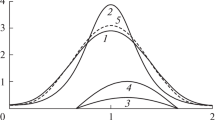Abstract
The exact solvable model presented here describes two interacting species whose populations oscillate periodically in time in the absence of self-interaction and attain saturation with fluctuations if self-interactions are included. While sharing broad features of the classical Volterra system, the model proposed here has the advantage of possessing exact solutions. The model thus provides a testing ground for general principles employed in the study of dynamics of populations.
Similar content being viewed by others
Literature
Bellman, R. 1953.Stability Theory of Differential Equations. New York: McGraw-Hill.
Goel, N. S., S. C. Maitra and E. W. Montroll, 1971. “On the Volterra and other Non-linear Models of Interacting Populations.”Rev. Mod. Phys.,43, 231–276.
Gompertz, B. 1825. “On the Nature of the Function expressive of the Law of Human Mortality, and on a New Mode of determining the Value of Life Contingencies.”Phil. Trans. Roy. Soc.,115, 513–585.
Leigh, E. G., Jr. 1968. “The Ecological Role of Volterra's Equations.” InSome Mathematical Problems in Biology, Gerstenhaber, M., ed. Providence R.I.: American Mathematical Society.
Volterra, V. 1931. Leçon sur la théorie mathématique de la lutte pour la vie. Paris: Gauthier-Villars.
Author information
Authors and Affiliations
Rights and permissions
About this article
Cite this article
Gomatam, J. A new model for interacting populations—I: Two-species systems. Bltn Mathcal Biology 36, 347–353 (1974). https://doi.org/10.1007/BF02464613
Received:
Revised:
Issue Date:
DOI: https://doi.org/10.1007/BF02464613




